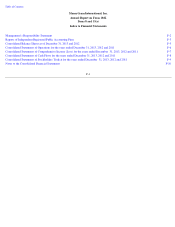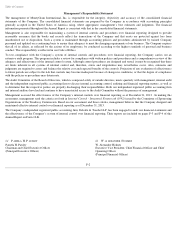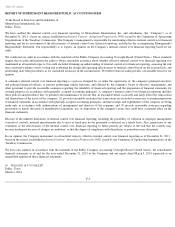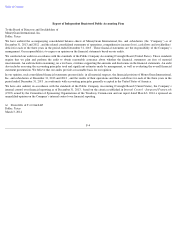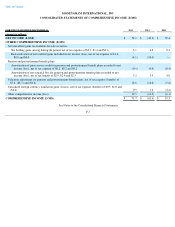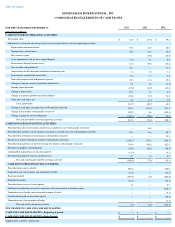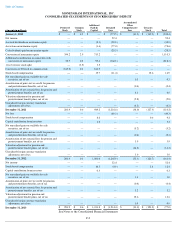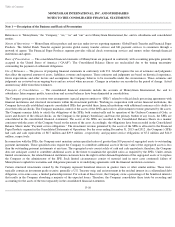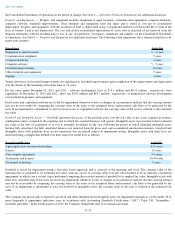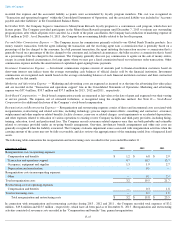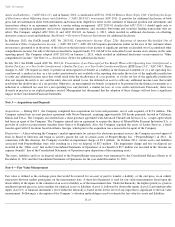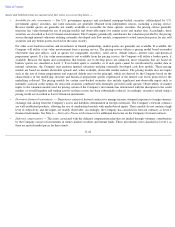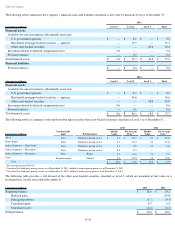MoneyGram 2013 Annual Report Download - page 78
Download and view the complete annual report
Please find page 78 of the 2013 MoneyGram annual report below. You can navigate through the pages in the report by either clicking on the pages listed below, or by using the keyword search tool below to find specific information within the annual report.
Table of Contents
MONEYGRAM INTERNATIONAL, INC. AND SUBSIDIARIES
NOTES TO THE CONSOLIDATED FINANCIAL STATEMENTS
Note 1 — Description of the Business and Basis of Presentation
References to “MoneyGram,” the “Company,” “we,” “us” and “our”
are to MoneyGram International, Inc. and its subsidiaries and consolidated
entities.
Nature of Operations
— MoneyGram offers products and services under its two
reporting segments: Global Funds Transfer and Financial Paper
Products. The Global Funds Transfer segment provides global money transfer services and bill payment services to consumers through a
network of agents. The Financial Paper Products segment provides official check outsourcing services and money orders through financial
institutions and agents.
Basis of Presentation
—
The consolidated financial statements of MoneyGram are prepared in conformity with accounting principles generally
accepted in the United States of America (“GAAP”).
The Consolidated Balance Sheets are unclassified due to the timing uncertainty
surrounding the payment of settlement obligations.
Use of Estimates —
The process of preparing financial statements in conformity with U.S. GAAP requires the use of estimates and judgments
that affect the reported amount of assets, liabilities, revenue and expenses. These estimates and judgments are based on historical experience,
future expectations and other factors and assumptions the Company believes to be reasonable under the circumstances. These estimates and
judgments are reviewed on an ongoing basis and are revised when necessary. Changes in estimates are recorded in the period of change. Actual
amounts may differ from these estimates.
Principles of Consolidation
—
The consolidated financial statements include the accounts of MoneyGram International, Inc. and its
subsidiaries. Intercompany profits, transactions and account balances have been eliminated in consolidation.
The Company participates in various trust arrangements (special purpose entities or “SPEs”)
related to official check processing agreements with
financial institutions and structured investments within the investment portfolio. Working in cooperation with certain financial institutions, the
Company historically established separate consolidated SPEs that provided these financial institutions with additional assurance of its ability to
clear their official checks. The Company maintains control of the assets of the SPEs and receives all investment revenue generated by the assets.
The Company remains liable to satisfy the obligations of the SPEs, both contractually and by operation of the Uniform Commercial Code, as
issuer and drawer of the official checks. As the Company is the primary beneficiary and bears the primary burden of any losses, the SPEs are
consolidated in the consolidated financial statements. The assets of the SPEs are recorded in the Consolidated Balance Sheets in a manner
consistent with the assets of the Company based on the nature of the asset. Accordingly, the obligations have been recorded in the Consolidated
Balance Sheets under “Payment service obligations.”
The investment revenue generated by the assets of the SPEs is allocated to the Financial
Paper Products segment in the Consolidated Statements of Operations. For the years ending December 31, 2013 and 2012 , the Company’
s SPEs
had cash and cash equivalents of $8.7 million and $29.9 million , respectively, and payment service obligations of $7.2 million and
$24.0
million , respectively.
In connection with the SPEs, the Company must maintain certain specified ratios of greater than 100 percent
of segregated assets to outstanding
payment instruments. These specified ratios require the Company to contribute additional assets if the fair value of the segregated assets is less
than the outstanding payment instruments at any time. The segregated assets consist solely of cash and cash equivalents; therefore, the Company
does not anticipate a need to contribute additional assets in the future to maintain the specified ratios as required by the SPEs. Under certain
limited circumstances, the related financial institution customers have the right to either demand liquidation of the segregated assets or to replace
the Company as the administrator of the SPE. Such limited circumstances consist of material (and in most cases continued) failure of
MoneyGram to uphold its warranties and obligations pursuant to its underlying agreements with the financial institution customers.
Certain structured investments owned by the Company represent beneficial interests in grantor trusts or other similar entities. These trusts
typically contain an investment grade security, generally a U.S. Treasury strip, and an investment in the residual interest in a collateralized debt
obligation, or in some cases, a limited partnership interest. For certain of these trusts, the Company owns a percentage of the beneficial interests
that results in the Company absorbing a majority of the expected losses. Therefore, the Company consolidates these trusts by recording and
accounting for the assets of the trust separately in the consolidated financial statements.
F-10


